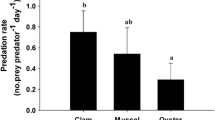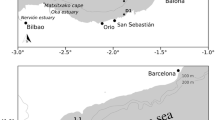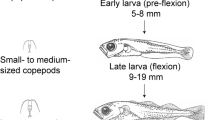Abstract
Fish larvae meet diverse environmental conditions at sea, and larval growth and chance of survival depend on a flexible response to environmental variability. The present study focuses on the flexibility of the foraging behaviour of larval cod in a series of laboratory experiments on larval search activity, prey selectivity, and hunger in a variable prey environment. Gadus morhua eggs were collected in March 1992 and 1993 from the Kattegat area, Denmark, fertilised and incubated in the laboratory. After hatching, the larvae were transferred to rearing tanks of 172 litres. The behaviour of larvae (6 to 7 mm long) was observed visually, and prey attacks, swimming activity and gut contents were registered across a range of 1 to 120 copepod nauplii l-1. When prey density decreased, larvae increased their swimming activity, increased their responsiveness to prey (distance of reaction) and decreased their prey size selectivity. Behavioural response was to a large degree determined by the level of hunger, represented by the number of newly ingested prey in the gut. The findings show that cod larvae have a flexible response to changes in feeding conditions and imply that larvae can grow and survive even in the lower range of (mean) prey densities measured at sea.
Similar content being viewed by others
References
Arthur DK (1977) Distribution, size and abundance of microcopepods in the California current system and their possible influence on survival of marine teleost larvae. Fish Bull US 75:601–611
Blaxter JHS (1970) Sensory deprivation and sensory input in rearing experiments. Helgoländer wiss Meeresunters 20:642–654
Browman HI, O'Brien WJ (1992) The ontogeny of search behaviour in white grappie, Pomoxis annularis. Envir Biol Fish 34:181–195
Chesson J (1978) Measuring preference in selective predation. Ecology 59:211–215
Croy MI, Hughes RN (1991) Effects of food supply, hunger, danger and competition on choice of foraging location by the fifteenspined stickleback, Spinachia spinachia L. Anim Behav 42:131–139
Dill LM (1983) Adaptive flexibility in the foraging behaviour of fishes. Can J Fish aquat Sciences 40:398–408
Ellertsen B, Solemdal P, Strømme T, Tilseth S, Westgård W, Moksness E, Øiestad V (1980) Some biological aspects of cod larvae (Gadus morhua). FiskDir Skr (Ser Havunders) 17:29–47
Ellertsen B, Fossum P, Solemdal P, Sundby S, Tilseth S (1984) A case study on the distribution of cod larvae and availability of prey organisms in relation to physical processes in Lofoten. In: Dahl E, Danielsen DS, Moksness E, Solemdal P (eds) The propagation of cod (Gadus morhua). Flødevigen Rapportser. 1, Arendal, Norway, pp 453–478
Ellertsen B, Fossum P, Solemdal P, Sundby S (1989) Relation between temperature and survival of eggs and first feeding larvae of northeast Arctic cod (Gadus morhua L.). Rapp P-v Réun Cons int Explor Mer 191:209–219
Holling CS (1959) Some characteristics of simple types of predation and parasitism. Can Ent 91:385–398
Houde ED, Schekter RC (1980) Feeding by marine fish larvae: developmental and functional responses. Envir Biol Fish 5:315–334
Hunter JR, Thomas GL (1974) Effect of prey distribution on the searching and feeding behaviour of larval anchovy Engraulis mordax Girard. In: Blaxter JHS (ed) Early life history of fish. Springer Verlag, Berlin, pp 559–574
Kislalioglu M, Gibson RN (1976) Prey ‘handling time’ and its importance in food selection by the 15-spined stickleback, Spinachia spinachia L. J exp mar Biol Ecol 25:151–159
MacKenzie BR, Leggett WC, Peters RH (1990) Estimating larval fish ingestion rates: can laboratory derived values be reliably extrapolated to the wild? Mar Ecol Prog Ser 67:209–225
MacKenzie BR, Kiørboe T (1995) Encounter rates and swimming behaviour of pause-travel and cruise larval fish predators in calm and turbulent laboratory environments. Limnol Ocean (submitted)
Munk P, Kiørboe T (1985) Feeding behaviour and swimming activity of larval herring (Clupea harengus L) in relation to density of copepod nauplii. Mar Ecol Prog Ser 24:15–21
Munk P (1992) Foraging behaviour and prey size spectra of larval herring Clupea harengus. Mar Ecol Prog Ser 80:149–158
O'Brien WJ, Browman HI, Evans BI (1990) Search strategies of foraging animals. Am Scient 78:152–160
Owen RW (1989) Microscale and finescale variations of small plankton in coastal and pelagic environments. J mar Res 47:197–240
Rosenthal H (1969) Investigations regarding the prey catching behaviour in larvae of the herring, Clupea harengus. Mar Biol 3:208–221
Rothschild BJ, Osborn TR (1988) Small-scale turbulence and plankton contact rates. J Plankton Res 10:465–474
Skiftesvik AB, Huse I (1987) Behaviour studies of cod larvae, Gadus morhua L. Sarsia 72:367–368
Solberg T, Tilseth S (1984) Growth, energy consumption and prey density requirements in first feeding larvae of cod (Gadus morrhua). In: Dahl E, Danielsen DS, Moksness E, Solemdal P (eds) The propagation of cod (Gadus morhua). Flødevigen Rapportser. 1, Arendal, Norway, pp 145–166
Støttrup JG, Richardson K, Kirkegaard E, Pihl NJ (1986) The cultivation of Acartia tonsa Dana for use as live food source for marine fish larvae. Aquaculture, Amsterdam 52:87–96
Sundby S, Fossum P (1990) Feeding conditions of Arcto-norwegian cod larvae compared with the Rothschild-Osborn theory on small scale turbulence and plankton contact rates. J Plankton Res 12:1153–1162
Werner EE, Hall DJ (1974) Optimal foraging and the size selection of prey by the bluegill sunfish (Lepomis macrochirus). Ecology 55:1042–1052
Author information
Authors and Affiliations
Additional information
Communicated by T. M. Fenchel, Helsingør
Rights and permissions
About this article
Cite this article
Munk, P. Foraging behaviour of larval cod (Gadus morhua) influenced by prey density and hunger. Marine Biology 122, 205–212 (1995). https://doi.org/10.1007/BF00348933
Received:
Accepted:
Issue Date:
DOI: https://doi.org/10.1007/BF00348933




